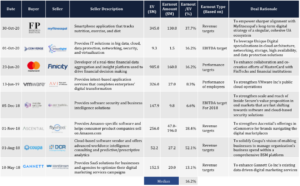Mind the (valuation) gap
Even with today’s buoyant markets, you might well find that you, as a technopreneur, have a difference in opinion on the valuation of your company with a prospective investor or buyer, even though there is strong interest. This valuation gap can be managed to a successful closing with just a little creativity.
This situation is more common with companies that do not have a long trading history and financials that convince the investor/buyer that they can safely extrapolate into the future i.e. most early stage and even growth stage tech companies, where there are always going to be business plan assumptions that have not yet been fully validated, but if they work out would take the company to the next level.
So here is the thing. You are almost always asking the investor/buyer to take a leap of faith, this leap sometimes being smaller or sometimes a little larger, and maybe they cannot leap all the way.
This is where effective communication between you and the investor/buyer is important as to where the gaps in belief are. If there is strong interest then there will be a lot of common ground of belief, which is a good base to work from.
The valuation gap can be managed through various mechanisms that agree a base valuation based on the “common ground of belief” and then an incremental value based on future events that validate or help to validate those “gaps in belief” assumptions.
First let’s look at valuation gaps in Investment transactions. The most common mechanism, particularly in an early stage tech company where it is difficult to justify a valuation whilst the revenues are still low, is an Unpriced Round, which can take the form of a Simple Agreement for Future Equity (SAFE) or a Convertible Loan Note (CLN).
Whilst many of the characteristics of the SAFE and CLN are similar, such as the investment amount, a valuation cap and the terms of subscription/conversion, a SAFE is essentially an equity instrument whilst the CLN is a debt instrument which attracts interest (which is usually capitalised). The terms of subscription are linked to a later event, typically the next investment round. For example this could be a 20% discount on the next investment round. The valuation cap is there to make the terms more attractive to new investors, by limiting the absolute maximum valuation for conversion at that future event, regardless of a discount or other terms.
Another mechanism for investment, often referred to as a “ratchet”, is to provide warrants for the issue of further shares to the investor in the case that the company does not make a future milestone, such as a revenue, profitability or other non-financial performance milestone (such as a regulatory approval, a product release or wining a key customer contract). The initial shares issued are based on the higher valuation assuming that the milestone will be reached, but if it is not, then more shares are issued to the investor, effectively diluting the existing investors with the net effect of a retrospective lower valuation.
A hybrid solution could be the issue of a base numbers of shares, with a SAFE or CLN for a portion of the investment which can convert at a higher valuation if the milestone is achieved or the lower valuation if it is not.
Finally, a mechanism which can be used for both investment and company sale is milestone-based staged closings. In this mechanism a percentage of the total committed investment or purchase of the company is typically transacted at each milestone. The first closing is usually immediate and is priced on the existing financials and parameters. The price of each subsequent milestone closing is based on a pre-agreed formula, typically based on revenue, EBITDA or other non-financial performance milestone.
The most commonly used mechanism in a company sale is the earnout. According to the American Bar Association, earnout has been used on average in 1 out of 4 deals over the last few years. Again, there is a base price that both buyer and seller agree, and then there are one or more incremental earnout payments based on future financial or non-financial performance milestones within specified periods of time.
Generally, the shorter the period (such as 1 year), the better for the technopreneur as the risk is probably lower and the money flows earlier. However, we have seen earnout periods of up to 4 years. It can become complicated to measure performance post the sale of a company, particularly when it is merged with another company, and especially over a longer period of time, where there could be other M&A activity or corporate changes that impact on the ability to measure performance. Given the vagaries of post purchase measurement, revenue is the easiest to measure, and usually the most relevant in a growing tech company.
Here are some examples of selected recent tech transactions:

Graphic by Allied Advisers using information from public filings and press releases.
An experienced transaction advisor can help with defining the most appropriate mechanism and negotiating the valuation gap. Whether it is investment in, or the sale of your company, the valuation gap can usually be bridged if there is sufficient commitment by you as the technopreneur and the investor/buyer to getting a deal done,
